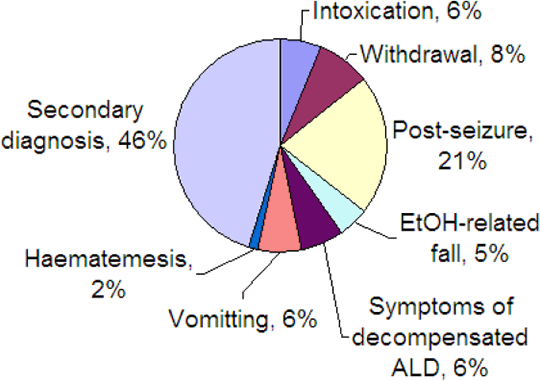Therapeutic difficulties of a symptom-triggered regimen for alcohol withdrawal syndrome on acute medical wards Background: Hospital admissions due to alcohol withdrawal syndrome (AWS) increased by 11% in England during 2010/2011 (1). During this time over 1 million alcohol-related admissions occurred, a figure which has more than doubled in the past 8 years (2). Very few high-quality clinical data are available to inform optimal pharmacological management of AWS. NICE guidelines recommend following a symptom-triggered regimen (e.g. CIWA-Ar) (3). The aim of this audit was to identify the therapeutic difficulties in managing AWS on the acute medical wards at Guy’s and St Thomas’ NHS Foundation Trust. Methods: Data on adherence to Trust guidelines for the treatment of AWS were collected on consecutive patients admitted over an 8 week period. These guidelines incorporate a nurse led CIWA-Ar regimen over the first 24 hours from admission during which chlordiazepoxide is administered in accordance with 2-hourly symptom monitoring to prevent deterioration. Total dose required over this period then determines/leads into a tapering fixed-dose programme. Results: 62 episodes from 58 patients (50(86%) male, age 51±12 years, mean±SD) with features of AWS were admitted and scored with CIWA-Ar. Primary diagnosis in 34(54%) was AWS (Fig.1). 28(46%) presented for another reason but developed AWS during the admission. Table 1 demonstrates the variation in guideline adherence in relation to CIWA-Ar assessment. CIWA-Ar monitoring fell below the guideline requirement with time delays between monitoring being >2 times recommended. After the initial 24 hours, 40(65%) patients should have received the fixed-dose programme but was only administered to 27(44%). 13 of 40 failed to receive further treatment however reasons for this were not indicated. 
Figure 1
Conclusion: The advantages of symptom-based regimens are that treatment is initiated on the basis of clinical severity and is individually tailored allowing more/less benzodiazepine to be prescribed depending on clinical need. However this relies on accurate and timely assessment of patients. This audit demonstrates the difficulties in successfully following a symptom-triggered regimen on busy acute medical wards. Erratic dosing, early treatment delays/discontinuation of the withdrawal programme were all observed and could result in clinical deterioration (e.g. Delirium-Tremens, seizures). The variability in successfully following a symptom-triggered regimen may outweigh its benefits compared to fixed-dose programmes alone; however more robust clinical data are required to investigate this. 1. The NHS Information Centre (2009) Statistics on alcohol: England. Leeds (on-line access) 2. Statistics on Alcohol: England (2012) Health and Social Care Information Centre (on-line access) 3. NICE guidance (2010) CG-100 Alcohol-use disorders: physical complications (on-line access) 4. NICE guidance (2010) CG-100 Alcohol-use disorders: physical complins |


